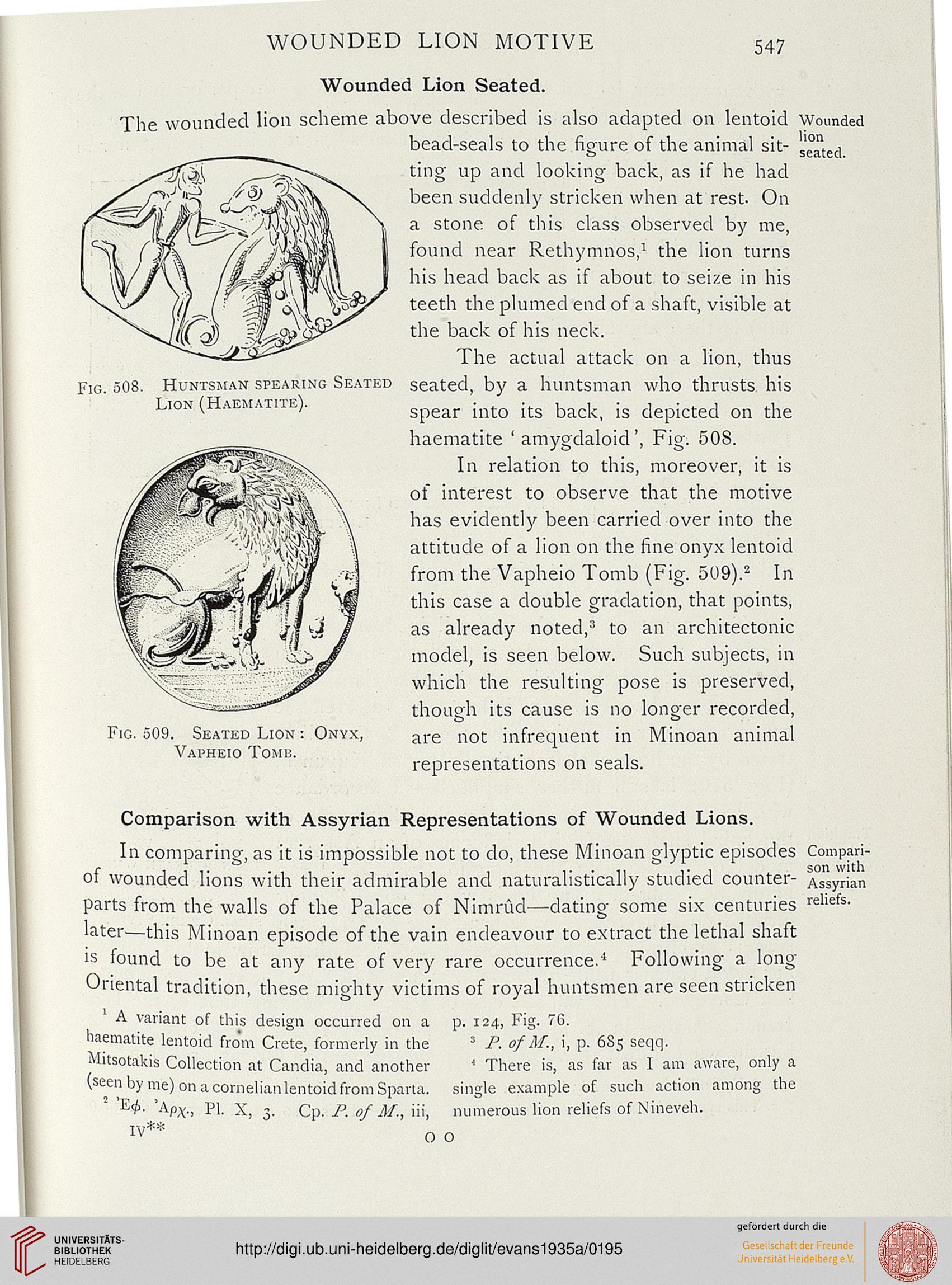WOUNDED LION MOTIVE
547
Fig. 5'
Huntsman spearing Seated
Lion (Haematite).
Wounded Lion Seated.
The wounded lion scheme above described is also adapted on lentoid Wounded
bead-seals to the figure of the animal sit- 's'™t ,
ting up and looking back, as if he had
been suddenly stricken when at rest. On
a stone of this class observed by me,
found near Rethymnos,1 the lion turns
his head back as if about to seize in his
teeth the plumed end of a shaft, visible at
the back of his neck.
The actual attack on a lion, thus
seated, by a huntsman who thrusts his
spear into its back, is depicted on the
haematite ' amygdaloid', Fig. 508.
In relation to this, moreover, it is
of interest to observe that the motive
has evidently been carried over into the
attitude of a lion on the fine onyx lentoid
from the Vapheio Tomb (Fig. 509).2 In
this case a double gradation, that points,
as already noted,3 to an architectonic
model, is seen below. Such subjects, in
which the resulting pose is preserved,
though its cause is no longer recorded,
are not infrequent in Minoan animal
representations on seals.
Fig. 509. Seated Lion
Vapheio Tome.
Onyx,
Comparison with Assyrian Representations of Wounded Lions.
In comparing, as it is impossible not to do, these Minoan glyptic episodes Compari-
of wounded lions with their admirable and naturalistically studied counter- Assyrian
parts from the walls of the Palace of Nimrild—datinaf some six centuries reliefs-
later—this Minoan episode of the vain endeavour to extract the lethal shaft
's found to be at any rate of very rare occurrence.4 Following a long
Oriental tradition, these mighty victims of royal huntsmen are seen stricken
A variant of this design occurred on a p. 124, Fig. 7G.
haematite lentoid from Crete, formerly in the J P. of it., i, p. 6S5 seqq.
Mltsotakis Collection at Candia, and another ' There is, as far as I am aware, only a
(seenbyme)onacornelianlentoidfromSpana. single example of such action among the
E£., 'Apx.-, PI. X, 3. Cp.vP..of M., iii, numerous lion reliefs of Nineveh.
547
Fig. 5'
Huntsman spearing Seated
Lion (Haematite).
Wounded Lion Seated.
The wounded lion scheme above described is also adapted on lentoid Wounded
bead-seals to the figure of the animal sit- 's'™t ,
ting up and looking back, as if he had
been suddenly stricken when at rest. On
a stone of this class observed by me,
found near Rethymnos,1 the lion turns
his head back as if about to seize in his
teeth the plumed end of a shaft, visible at
the back of his neck.
The actual attack on a lion, thus
seated, by a huntsman who thrusts his
spear into its back, is depicted on the
haematite ' amygdaloid', Fig. 508.
In relation to this, moreover, it is
of interest to observe that the motive
has evidently been carried over into the
attitude of a lion on the fine onyx lentoid
from the Vapheio Tomb (Fig. 509).2 In
this case a double gradation, that points,
as already noted,3 to an architectonic
model, is seen below. Such subjects, in
which the resulting pose is preserved,
though its cause is no longer recorded,
are not infrequent in Minoan animal
representations on seals.
Fig. 509. Seated Lion
Vapheio Tome.
Onyx,
Comparison with Assyrian Representations of Wounded Lions.
In comparing, as it is impossible not to do, these Minoan glyptic episodes Compari-
of wounded lions with their admirable and naturalistically studied counter- Assyrian
parts from the walls of the Palace of Nimrild—datinaf some six centuries reliefs-
later—this Minoan episode of the vain endeavour to extract the lethal shaft
's found to be at any rate of very rare occurrence.4 Following a long
Oriental tradition, these mighty victims of royal huntsmen are seen stricken
A variant of this design occurred on a p. 124, Fig. 7G.
haematite lentoid from Crete, formerly in the J P. of it., i, p. 6S5 seqq.
Mltsotakis Collection at Candia, and another ' There is, as far as I am aware, only a
(seenbyme)onacornelianlentoidfromSpana. single example of such action among the
E£., 'Apx.-, PI. X, 3. Cp.vP..of M., iii, numerous lion reliefs of Nineveh.





